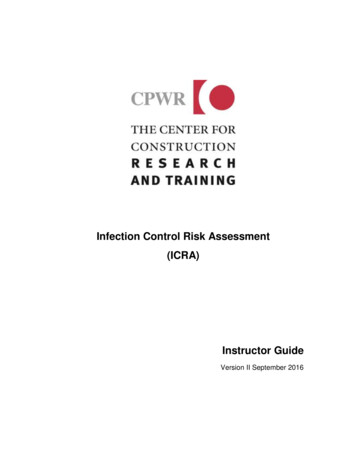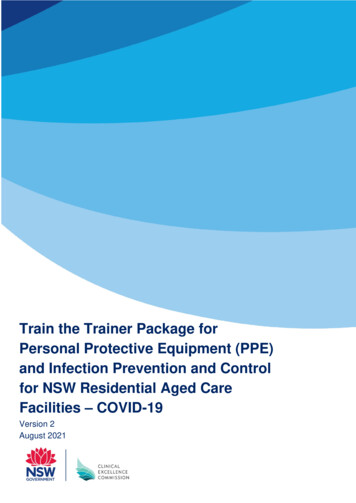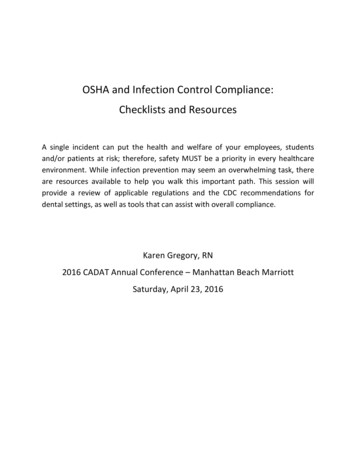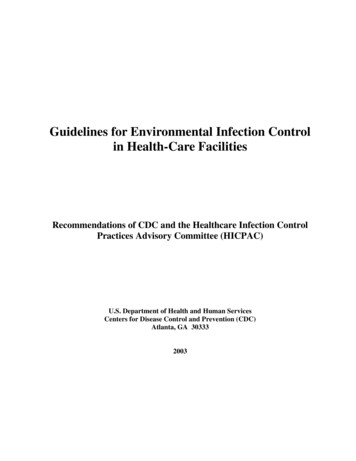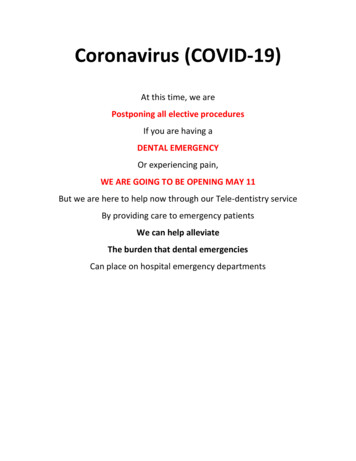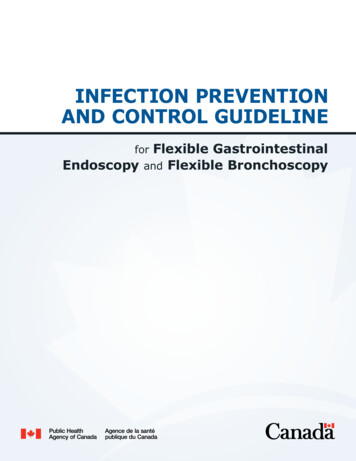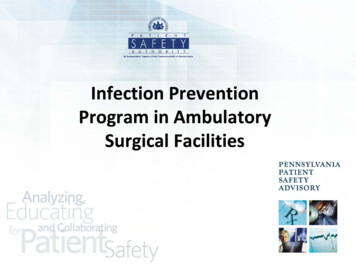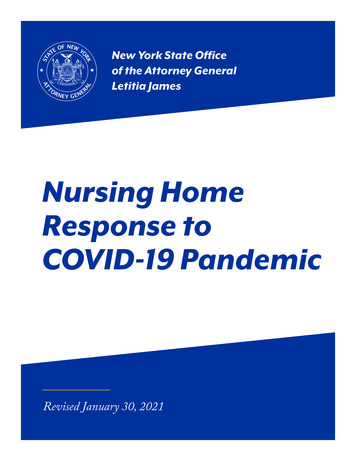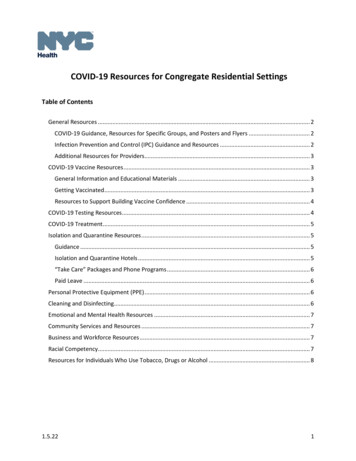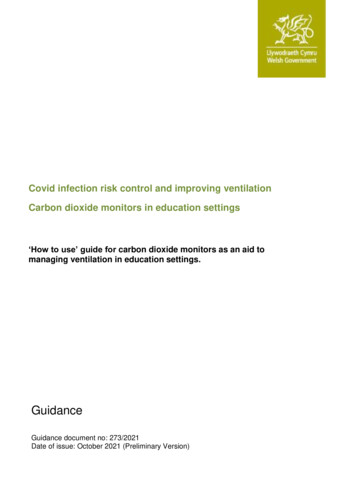
Transcription
Covid infection risk control and improving ventilationCarbon dioxide monitors in education settings‘How to use’ guide for carbon dioxide monitors as an aid tomanaging ventilation in education settings.GuidanceGuidance document no: 273/2021Date of issue: October 2021 (Preliminary Version)
Carbon dioxide monitors in educationsettingsAudienceThis guidance is aimed at schools, further educationand higher education institutions.OverviewThe guidance will assist in the use of carbon dioxidemonitors in learning spaces to support themanagement of ventilation.Action requiredThe guidance can be used in all education settingsutilising carbon dioxide monitors.Further information Enquiries about this document should be directed to:Education Business Planning and GovernanceThe Education DirectorateWelsh GovernmentCathays ParkCardiffCF10 3NQTel: 03000 257672e-mail: 21stcenturyschools@gov.walesAdditional copiesThis document can be accessed from the WelshGovernment’s website at Home GOV.WALESRelated documents Local COVID-19 infection control decision frameworkfor schools from autumn e operation guidance: post-16 learning providersSafe operation guidance: post-16 learning providers GOV.WALESMae’r ddogfen yma hefyd ar gael yn Gymraeg.This document is also available in Welsh. Crown copyright 2021 WG 43616
Contents1.2.3.4.5.6.7.8.IntroductionWhere should you use CO2 monitors?Placement of monitors and measuringUnderstanding readingsRisk AssessmentsImproving ventilationQ and AQuick guide2345679101
1. IntroductionThis guidance sets out how education settings can use Carbon Dioxide (CO2) monitors as an aidfor the management of ventilation. The guidance will be dynamic in nature thus being kept underreview during its implementation. The guidance should be read in conjunction with the decisionframework and risk assessment for your location.The requirement to take reasonable measures applies in a very broad range of circumstances,including every kind of workplace which is open. This includes for example; public services, healthand social care premises, schools and childcare settings, higher education, further educationsettings (including training centres and adult learning), call centres, hospitality businesses,travel and holiday accommodation, voluntary services, commercial and industrial premises,construction sites and other open sites such as roadworks and outdoor places including livestockmarkets.The duty in law to take reasonable measures applies to the person or persons responsible forpremises open to the public and on the person responsible for the work being undertaken in anyworkplace; that is the person responsible for management control of the premises.It is the responsibility of those in control of premises (head teachers/principals etc.) to ensure goodlevels of ventilation are maintained in buildings. For schools, local authority estates and corporatehealth and safety teams should be contacted for support. Colleges and universities should workwith their estates/facilities management and corporate health and safety teams. For non-statemaintained childcare settings, owners should work with their own health and safety advisor andfacilities management provider.Good ventilation can help reduce the risk of spreading coronavirus, so a focus on improvinggeneral air flow, preferably through fresh air or effective mechanical systems, can help to create asafer environment for staff, pupils and students. You can generally maintain and increase thesupply of fresh air by simply opening windows and doors – although internal fire doors mustremain closed unless connected to a device that causes them to self-close upon activation of thefire alarm.People exhale carbon dioxide (CO2) when they breathe out. If there is a build-up of CO2 in an areait can indicate that ventilation needs improving. You can use CO2 monitors to help you: identify areas of poor ventilation; and gauge how much you need to open the windows or improve mechanical ventilation(including air conditioning).It is important to remember that CO2 monitors are an indicator of ventilation status and notinfection risk.There are many different types of CO2 monitors available. The most effective portable devices touse are non-dispersive infrared (NDIR) CO2 monitors. This is the type provided by the WelshGovernment to state funded education settings over the autumn term 2021.2
The monitors allow for assessment of ventilation in spaces and informs their risk assessment withregard to ventilation.The CO2 monitorsprovided by the WelshGovernment areRototherm AM60units. This guidanceshould be read inconjunction with theInstruction Manualprovided with thisunit.Other CO2 monitors may be used to follow this guidance but care must be taken to ensure anydifferences in units are taken into account.Estates and/or facilities management teams must ensure CO2 monitors are maintained andcalibrated in accordance with the Instruction Manual provided.2. Where should you use CO2 monitors?CO2 monitors are best suited to spaces which are densely occupied for approximately one hour ormore.In education and childcare settings this includes, but is not limited to:teaching spaces (including lecture rooms, classrooms and practical teaching spaces)indoor play spaces (e.g. rooms in nurseries)staff rooms, large offices, meeting rooms, group or breakout roomsMonitoring is not recommended for use in areas where CO2 monitors are unlikely to give reliablereadings, including:large, open internal spaces and spaces with higher ceilings, such as sports halls or atriumsspaces that are densely occupied for shorter periods, such as corridors or lobbiesareas with low occupancy density including kitchens and toilets, or offices with one or twooccupantsRooms that already have CO2 monitoring integral to their building management system may notrequire additional standalone monitors. Your estates or facilities management team should know ifmonitoring is already in place.3
3. Placement of monitors and measuringPlacementWhen deciding where to place monitors, you should initially prioritise spaces that feel constantlystuffy or persistent smell as these are likely to be under-ventilated. Using a monitor in thesespaces first can help you prioritise action effectively. You should place CO2 monitors: at head height when seated away from ventilation outlets, such as grilles or windows at least 0.5 m away from occupants (closer than this could give inaccurate readings)If your measurements in an occupied space seem very low (far below 400ppm) or very high (over1500ppm), it’s possible your monitor is in the wrong location and you should move it to anotherlocation in the space to get a more accurate reading.Monitors should be placed where the display can be seen by a member of school staff so that theycan identify if the display colour changes to amber or red.Measuring After 3 minutes warm-up the monitor provided by the Welsh Government will be ready for use. When to measure: Depending on how the room is being used, staff should check the measureshown on screen at the beginning of class and at the end and monitor this. Staff may wish tocheck mid-way if for instance, the class is over an hour duration. There should be no need tointerrupt a lesson to take a reading. You may also wish to monitor more frequent measurements in situations whereby the1500ppm is observed to be exceeded frequently. These measurements will help inform theaverage CO2 levels across the day. Measuring need only be carried out in occupied rooms.Rotation of monitors (if required)You can rotate monitors around the building and the spaces that are suitable for monitoring, sothat you can identify ventilation needs across your setting. Rooms should be monitored for at leastone full day before rotating them to a different space. You can keep your rota simple: start withpotentially under-ventilated rooms as set out above and then move your monitors to other rooms(prioritise those most used/with the highest occupation density).If you find that rooms are consistently well ventilated there is no need to continue keeping them onyour rota for monitoring CO2 levels unless occupancy or use of room is changed. If placed in anew room, the monitor might need to refresh (produce a new measure) a few times before settlingon a new reading.4
4. Understanding readingsThe amount of CO2 in the air is measured in parts per million (ppm). A consistent value under800ppm, indicated by a green light, does not require any action and implies that a space is wellventilated. Background ventilation should still be provided in order to maintain good air quality.A value over 800ppm indicated by an amber light should be seen as an indicator of inadequatebackground ventilation and a need to increase the ventilation further. If not done so already, youshould start to improve ventilation by simply opening windows and/or doors (fire doors mustremain closed unless connected to a device that causes them to self-close upon activation of thefire alarm) or increasing the levels of mechanical ventilation.A consistent value of over 1500ppm CO2 concentration indicated by a red light in an occupiedspace is an indicator of poor ventilation. You should take action to improve ventilation where CO2readings are consistently higher than 1500ppm as described in section 6 -Improving ventilation.In summaryLESS THAN 800 PPM No action requiredas this is anadequate level ofventilation.ContinuemonitoringIf levels start toincrease this is anearly indication thatventilation mayneed to beincreasedBackgroundventilation shouldalways bemaintained800 PPM TO 1500 PPM 800 PPM TO 1500 PPMOCCASIONALLYCONSISTENTLY Increaseventilation bysimply openingwindows anddoors (fire doorsshould not be leftopen unlessconnected to adevice thatcauses them toself-close uponactivation of thefire alarm)Purge before andafter each lessonby simply openingall windows anddoors fully for upto ten minutesLimit learnernumber wherepossibleMove high levelactivities such asdance, music orphysical activitiesto well ventilatedspaces Report to estates orfacilitiesmanagement orperson responsiblefor the building to;Increase the ratedelivered bymechanicalventilation (includingair conditioning) unitswill help to optimisethe efficiency of themand this is likely toreduce running costs.Extend timings ofmechanicalventilation (includingair conditioning) unitsto purge air beforeand after lessonsCheck and clean alllocal mechanicalventilationConsider whetheradditional measuresand/or interventionscould helpOVER 1500 PPM Consult withestates or facilitiesmanagement orpersonresponsible for thebuilding toconsiderintroductingadditionalmechanical ornatural ventilationbest suited to theindividual location.Purge ventilationwill be necessaryas soon aspossibleRemember to look out for consistently high values: Because many factors influence the level ofCO2 measured in a space, a single snapshot reading is unlikely to be reliable. We thereforerecommend waiting for 5 minutes before retaking a high reading, to allow for the monitor to settle.Measurements within a space can vary during the day due to changes in numbers of occupants,activities, or ventilation rates. Doors and windows being open or closed can also have an effect.5
Instantaneous or ‘snapshot’ CO2 readings can be misleading, so you should take severalmeasurements throughout the day frequently enough to represent changes in use of the room orspace. Then calculate an average value for the occupied period.You may need to repeat monitoring at different times of the year as outdoor temperatures changeand this will affect behaviour relating to opening windows and doors when your space relies onnatural ventilation.Your readings will help you decide if a space is adequately ventilated.5. Risk assessmentsThe use of CO2 monitors and any associated risk assessments for ventilation should be taken inconjunction with Welsh Government’s published Local COVID-19 infection control decisionframework for schools from autumn 2021.Your setting risk assessment should cover identifying any poorly ventilated spaces, includingthrough the use of CO2 monitors if available. If you do not already address ventilation in yourassessment, you should add this as soon as you receive your CO 2 monitors.You should consider in your risk assessments the potential for certain activities to affect CO2levels e.g. singing, shouting, physical exercise, use of gas appliance such as cooking or BunsenBurners in science labs.You should note that health and safety law says that employers, including education and childcaresettings which are the employers for their settings, must take reasonable measures to ensurethere is an adequate supply of fresh air (ventilation) in enclosed areas of the workplace. This hasnot changed during the COVID-19 pandemic.To whom does the legal requirement apply?The requirement to take reasonable measures applies in a very broad range of circumstances,including every kind of workplace which is open. This includes for example; public services, healthand social care premises, schools and childcare settings, higher education, further educationsettings (including training centres and adult learning), call centres, hospitality businesses, traveland holiday accommodation, voluntary services, commercial and industrial premises, constructionsites and other open sites such as roadworks and outdoor places including livestock markets.The duty in law to take reasonable measures applies to the person or persons responsible forpremises open to the public and on the person responsible for the work being undertaken in anyworkplace; that is the person responsible for management control of the premises.6
6. Improving ventilationWhere CO2 readings are between 800ppm and 1500ppm small interventions such as openingwindows and doors should be adequate to bring levels below 800ppm. High level open windowswill provide ventilation without causing draughts. It is important to remember that a small amountof continuous background ventilation should always be maintained, even when monitors displaylevels below 800ppm.Other local interventions to consider: purge the classroom before and after each class / lesson by simply opening all windowsand doors fully for up to ten minutes having doors or windows at opposite ends or sides of classrooms open rather than just oneor two centrally will provide better air flow circulation limit learner numbers where possible in further or higher education provide comfort breaks during longer lessons move activities such as dancing or singing to larger and/or better ventilated spaces where windows are sealed or difficult to open, or air vents are blocked, this should beremedied as soon as possible through your estates or facilities management. For schools,this will be your local authorityWhere readings still remain between 800ppm and 1500ppm despite local interventions you shouldconsult your estates or facilities teams (or person responsible for the building) to consider suchthings as: ensuring regular maintenance (including filter changes) and running of mechanical;ventilation (including air conditioning) will help to optimise the efficiency of them and thisis likely to reduce running costs; extend timings of mechanical ventilation (including air conditioning) to purge air beforeand after lessons; check, clean and increase ventilation rates of all local mechanical ventilation (including airconditioning); and consider whether additional measures and/or interventions could help.Additional ventilation, mechanical or natural, should be considered if the readings are consistentlyover 1500ppm, and your estates or facilities teams (local authority for schools) should advise onthe best solution to each individual case. In the interim, you should consider moving to otherrooms, repurposing space elsewhere in the estate or limiting numbers.Levels of above 1500ppm are a sign of poor ventilation and should be addressed as part of yourworkplace/teaching space assessment.Care needs to be taken of draughts from open windows or doors causing hazards, particularly inScience and Design and Technology classrooms in secondary schools. Having doors open maypose safeguarding and security issues. Purge ventilation between lessons or mechanicalventilation may be required for such areas, and form part of the school’s risk assessment.7
Comprehensive advice on how to improve ventilation in your setting is available from Public HealthWales, and the Health and Safety Executive. Details can be accessed via: Public Health Wales’s (PHW) guidance on ventilation of indoor spaces to stop the spreadof coronavirus (COVID-19)Ventilation and Air Conditioning - Public Health Wales (nhs.wales) The Health and Safety Executive’s (HSE) guidance on ventilation and air conditioningduring the coronavirus (COVID-19) pandemicVentilation and air conditioning during the coronavirus (COVID-19) pandemic (hse.gov.uk)8
7. Questions and AnswersQuestion: My CO2 monitor delivery hasn’t arrived, what can I do?Answer: For schools please contact your local authority and for colleges and universities pleasecontact your estates or facilities management team. They will be able to assist on all questionsrelating to deliveries.Question: My CO2 monitor is faulty, what can I do?Answer: Please contact the supplier of your device directly. For Welsh Government suppliedunits this will be Lyreco via their Corporate Account Manager Milena-Jane Thomasmilena.thomas@lyreco.com ; they will be able to assist on all questions relating to faults.Question: I haven’t got enough CO2 monitors, how can I access more?Answer: You will receive roughly one device per classroom. We recommend creating a rota planand move monitors around the premises, if needed. If you have fewer devices than this and yoususpect there has been a mistake please get in touch with the 21st Century Schools and Collegesteam.Question: I have taken the suggested remedial actions but my CO2 monitor is still persistentlyreading over 800ppm, what should I do?Answer: We expect the vast majority of fixes to be relatively minor, however if levels areconsistently over 800ppm you should consult with your estates or facilities team (local authority forschools) to review remedial options.Question: I already have CO2 monitors in my education settings, should I continue to use them?Answer: Yes, if you already have CO2 monitors installed you should continue to use them. Anyadditional CO2 monitors you receive can be used to check rooms that are not fitted with monitors.9
VENTILATION IN EDUCATION SETTINGSCarbon Dioxide (CO2) monitors as an aid tomanaging ventilation in education settingsQuick guide to actions to take at different CO2 levelsLESS THAN 800 PPM No action required as this isan adequate level ofventilation.Continue monitoringIf levels start to increase thisis an early indication thatventilation may need to beincreasedBackground ventilationshould always bemaintained800 PPM TO 1500 PPM OCCASIONALLY 800 PPM TO 1500 PPM CONSISTENTLY Increase ventilation by simply openingwindows and doors (fire doors shouldnot be left open unless connected to adevice that causes them to self-closeupon activation of the fire alarm)Purge before and after each lessonby simply opening all windows anddoors fully for up to ten minutesLimit learner number where possibleMove high level activities such asdance, music or physical activities towell ventilated spaces Report to estates or facilitiesmanagement or person responsible forthe building to;Increase the rate delivered bymechanical ventilation (including airconditioning) units will help to optimisethe efficiency of them and this is likelyto reduce running costs.Extend timings of mechanicalventilation (including air conditioning)units to purge air before and afterlessonsCheck and clean all local mechanicalventilationConsider whether additional measuresand/or interventions could helpOVER 1500 PPM Consult with estates orfacilities management orperson responsible for thebuilding to considerintroducting additionalmechanical or naturalventilation best suited tothe individual location.Purge ventilation will benecessary as soon aspossibleAdditional informationGood ventilation can help reduce the risk of spreading coronavirus, so a focus on improving general air flow, preferably through fresh air or effective mechanical systems,can help to create a safer environment for staff, pupils and students. You can generally maintain and increase the supply of fresh air by simply opening windows and doors– although internal fire doors must remain closed unless connected to a device that causes them to self-close upon activation of the fire alarm. Links to related documentsand further advice can be accessed Safe operation guidance: post-16 learning providers GOV.WALESVentilation and Air Conditioning - Public Health Wales (nhs.wales)Ventilation and air conditioning during the coronavirus (COVID-19) pandemic (hse.gov.uk)10
After 3 minutes warm-up the monitor provided by the Welsh Government will be ready for use. When to measure: Depending on how the room is being used, staff should check the measure shown on screen at the beginning of class and at the end and monitor this. Staff may wish to check mid-way if for instance, the class is over an hour duration.


